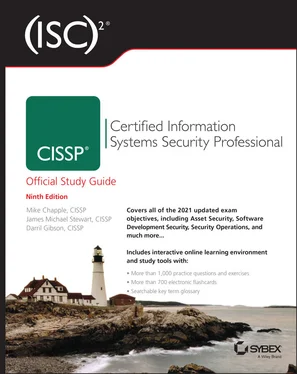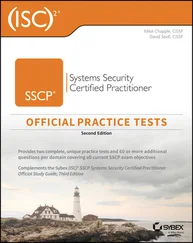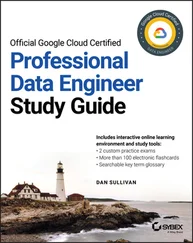5 A. Network hardware devices, including routers, function at layer 3, the Network layer. Layer 1, the Physical layer, is where repeaters and hubs operate, not routers. The Transport layer, layer 4, is where circuit level firewalls and proxies operate, not routers. Layer 5, the Session layer, does not actually exist in a modern TCP/IP network, and thus no hardware directly operates at this layer, but its functions are performed by TCP in the Transport layer, layer 4, when sessions are in use.
6 D. Stateful inspection firewalls (aka dynamic packet-filtering firewall) enable the real-time modification of the filtering rules based on traffic content and context. The other firewalls listed as options—static packet filtering, application level, and circuit level—are all stateless and thus do not consider the context when applying filtering rules.
7 D. A virtual private network (VPN) link can be established over any network communication connection. This could be a typical LAN cable connection, a wireless LAN connection, a remote access dial-up connection, a WAN link, or even an internet connection used by a client for access to the office LAN.
8 C. A Trojan horse is a form of malware that uses social engineering tactics to trick a victim into installing it—the trick is to make the victim believe that the only thing they have downloaded or obtained is the host file, when in fact it has a malicious hidden payload. Viruses and logic bombs do not typically use social engineering as an element in their means of infecting a system. A worm sometimes is designed to take advantage of social engineering, such as when the worm is an executable email attachment and the message tricks the victim into opening it. However, not all worms are designed this way—this is a core design concept of a Trojan horse.
9 D. The components of the CIA Triad are confidentiality, availability, and integrity. The other options are not the terms that define the CIA Triad, although they are security concepts that need to be evaluated when establishing a security infrastructure.
10 B. Privacy is not necessary to provide accountability. The required elements of accountability, as defined in AAA services, are as follows: identification (which is sometimes considered an element of authentication, a silent first step of AAA services, or represented by IAAA), authentication (i.e., identification verification), authorization (i.e., access control), auditing (i.e., logging and monitoring), and accounting.
11 C. Group user accounts allow for multiple people to log in under a single user account. This allows collusion because it prevents individual accountability. Separation of duties, restricted job responsibilities, and job rotation help establish individual accountability and control access (especially to privileged capabilities), which in turn limits or restricts collusion.
12 B. The data owner must first assign a security label to a resource before the data custodian can secure the resource appropriately. Senior management is ultimately responsible for the success or failure of a security endeavor. An auditor is responsible for reviewing and verifying that the security policy is properly implemented, that the derived security solutions are adequate, and that user events are in compliance with security policy. The security staff is responsible for designing, implementing, and managing the security infrastructure once approved by senior management.
13 C. The Managed phase (level 4) of the SW-CMM involves the use of quantitative development metrics. The Software Engineering Institute (SEI) defines the key process areas for this level as Quantitative Process Management and Software Quality Management. The Repeatable phase (level 2) is where basic lifecycle processes are introduced. The Defined phase (level 3) is where developers operate according to a set of formal, documented development processes. The Optimizing phase (level 5) is where a process of continuous improvement is achieved.
14 B. Layers 1 and 2 contain device drivers but are not normally implemented in practice, since they are often collapsed into layer 0. Layer 0 always contains the security kernel. Layer 3 contains user applications. Layer 4 does not exist in the design concept, but it may exist in customized implementations.
15 B. The SYN flagged packet is first sent from the initiating host to the destination host. The destination host then responds with a SYN/ACK flagged packet. The initiating host sends an ACK flagged packet, and the connection is then established. The FIN flagged packet is not used in the TCP three-way handshake to establish a session; it is used in the session teardown process.
16 B. Parameter checking (i.e., confirming input is within reasonable boundaries) is used to prevent the possibility of buffer overflow attacks. Time-of-check to time-of-use (TOCTTOU) attacks are not directly addressed by parameter checking or input filtering; defensive coding practices are needed to eliminate or reduce this issue. SYN flood attacks are a type of DoS, which is not fully protected against with just improved coding practices. A DDoS is also not prohibited by just improved coding practices such as parameter checking. For any type of DoS, adequate filtering and processing capacity are the most effective security responses.
17 A. The ⊕ symbol represents the XOR function and returns a true value when only one of the input values is true. If both values are false or both values are true, the output of the XOR function is false. Option B is the result if these two values were combined using the AND (the ∧ symbol) function, which returns a value of true if the two values are both true. Option C is the result if these two values were combined using the OR (the ∨ symbol) function, which returns a value of true if either input values is true. Option D is the result if only the X value was subjected to the NOR (the ~ symbol) function, which reverses the value of an input.
18 A, C, E, F, I, J. There are six standard data type classifications used in either a government/military or a private sector organization in this list of options: public, private, sensitive, proprietary, critical, and confidential. The other options (healthy, internal, essential, certified, and for your eyes only) are incorrect since they are not typical or standard classifications.
19 C. The correct statement is regarding the data controller. The other statements are incorrect. The correct versions of those statements are as follows. A data owner is the entity assigned specific responsibility for a data asset in order to ensure its protection for use by the organization. A data processor is the entity that performs operations on data. A data custodian is the entity assigned or delegated the day-to-day responsibility for proper storage and transport as well as protecting data, assets, and other organizational objects.
20 C. Any recipient can use Mike's public key to verify the authenticity of the digital signature. Renee's (the recipient) public key is not used in this scenario. However, it could be used to create a digital envelope to protect a symmetric session encryption key sent from Mike to Renee. Renee's (the recipient) private key is not used in this scenario. However, it could be used if Renee becomes a sender to send Mike a digitally signed message. Mike's (the sender) private key was used to encrypt the hash of the data to be sent to Renee, and this is what creates the digital signature.
21 D. In this scenario, the data is encrypted at rest with AES-256. There is no mention of encryption for transfer or processing. The data is not stored redundantly, since it is being moved, not copied, to the central data warehouse, and there is no mention of a backup.
22 A. The data owner is the person(s) (or entity) assigned specific responsibility for a data asset in order to ensure its protection for use by the organization. The data controller is the entity that makes decisions about the data they are collecting. A data processor is the entity that performs operations on data on behalf of a data controller. A data custodian or steward is a subject who has been assigned or delegated the day-to-day responsibility for proper storage and transport as well as protecting data, assets, and other organizational objects.
Читать дальше












